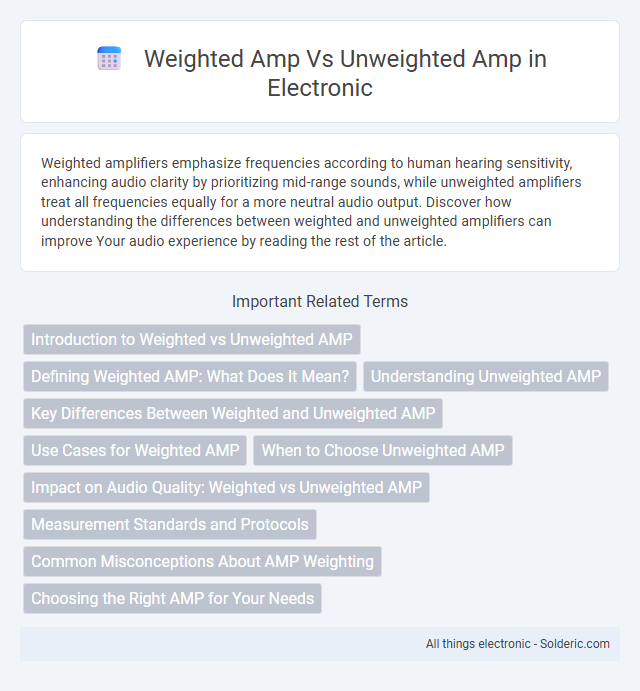Weighted amplifiers emphasize frequencies according to human hearing sensitivity, enhancing audio clarity by prioritizing mid-range sounds, while unweighted amplifiers treat all frequencies equally for a more neutral audio output. Discover how understanding the differences between weighted and unweighted amplifiers can improve Your audio experience by reading the rest of the article.
Comparison Table
| Feature | Weighted AMP | Unweighted AMP |
|---|---|---|
| Definition | Calculates average magnitude considering weight factors. | Calculates average magnitude without weights. |
| Calculation | Sum of (amplitude x weight) / total weights. | Sum of amplitudes / number of data points. |
| Use Case | When different data points have varying importance. | For general average measurement without bias. |
| Accuracy | Higher accuracy in heterogeneous datasets. | May misrepresent datasets with variable significance. |
| Complexity | More complex due to weight assignment. | Simpler calculation process. |
| Example | Weighted average amplitude in seismic signal analysis considering sensor reliability. | Average amplitude calculated directly from amplitudes. |
Introduction to Weighted vs Unweighted AMP
Weighted AMP assigns varying importance to individual data points based on their relevance or frequency, enhancing the model's precision in handling imbalanced datasets. Unweighted AMP treats all data points equally, providing a straightforward but potentially less accurate representation when data distribution is uneven. Understanding the distinction between Weighted and Unweighted AMP is crucial for optimizing algorithm performance in diverse data environments.
Defining Weighted AMP: What Does It Mean?
Weighted AMP refers to an adjusted measure of average monthly pageviews or visits that accounts for the relative importance or influence of different data sources, giving more significance to higher-quality or more relevant traffic. This method provides a more accurate reflection of your site's true engagement by filtering out noise from less valuable or spammy visits. Understanding Weighted AMP helps you evaluate your website performance with greater precision, making informed decisions based on meaningful audience interactions.
Understanding Unweighted AMP
Unweighted AMP measures the average marks or scores without considering the credit value or weight of individual subjects, reflecting a straightforward calculation of your academic performance. This method treats all courses equally regardless of their difficulty or importance, which might not accurately represent your true proficiency in core subjects. Understanding unweighted AMP helps you see a basic overview of your results before applying weighted adjustments for a more precise academic assessment.
Key Differences Between Weighted and Unweighted AMP
Weighted AMP accounts for the quantity of attempts by assigning different importance to each question based on difficulty, providing a more precise measure of student performance. Unweighted AMP treats all questions equally regardless of difficulty, offering a straightforward but less nuanced score. The key difference lies in how scores reflect student ability: weighted AMP captures skill variance more effectively, while unweighted AMP emphasizes raw accuracy.
Use Cases for Weighted AMP
Weighted AMP is essential in scenarios where certain data points require greater influence on model training, such as imbalanced datasets or domain-specific personalization, ensuring more accurate and fair results. It optimizes performance in natural language processing tasks by amplifying significant token contributions, improving context understanding and prediction quality. This approach benefits recommendation systems and fraud detection models by emphasizing critical features, enhancing overall robustness and reliability.
When to Choose Unweighted AMP
Unweighted AMP is ideal for applications requiring raw audio signal amplification without frequency emphasis, such as in audio testing or laboratory measurements where flat frequency response is critical. It avoids any frequency weighting that could distort true signal levels, ensuring accurate representation of the original signal strength. This makes unweighted amplifiers suitable for precise instrumentation and diagnostic scenarios where unbiased amplification is necessary.
Impact on Audio Quality: Weighted vs Unweighted AMP
Weighted amps measure audio signals with frequency sensitivity that mimics human hearing, enhancing clarity and detail in sound reproduction. Unweighted amps treat all frequencies equally, which can result in less accurate audio representation, especially in complex soundscapes. Your choice between weighted and unweighted amps significantly impacts audio quality by determining how faithfully the amplifier preserves nuanced sound dynamics and tonal balance.
Measurement Standards and Protocols
Weighted amplifiers adhere to measurement standards such as A-weighting or C-weighting filters that simulate human hearing sensitivity, ensuring accurate audio level representation in diverse environments. Unweighted amplifiers bypass these filters, providing raw, flat-frequency measurements that might not reflect perceived loudness but are valuable for technical analysis and equipment testing. Understanding these protocols allows you to select the appropriate amplifier type for precise sound measurement or entertainment purposes.
Common Misconceptions About AMP Weighting
Common misconceptions about AMP weighting involve confusing weighted AMP with improved sound quality, while it primarily emphasizes frequency response alignment to human hearing sensitivity. Weighted AMP values apply frequency-specific adjustments based on standards like A-weighting to better represent perceived loudness, whereas unweighted AMP measures raw signal strength without these auditory filters. Understanding this distinction clarifies that weighted AMP aims to provide more relevant acoustic data, not inherently higher performance.
Choosing the Right AMP for Your Needs
Weighted AMP accounts for user engagement by prioritizing meaningful interactions, making it ideal for content with frequent user interaction. Unweighted AMP treats all interactions equally, suitable for straightforward data without variable user impact. Choose your AMP type based on the complexity and significance of user engagement to optimize performance and relevance.
Weighted amp vs Unweighted amp Infographic

 solderic.com
solderic.com